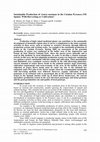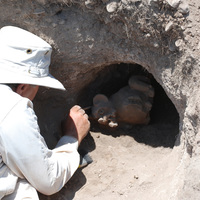Papers by Roser Cristóbal
Journal of Herbs, Spices & Medicinal Plants, Sep 17, 2008
Experimental studies were done with Arctostaphylos uva ursi (bearberry) in the Pyrenees, to deter... more Experimental studies were done with Arctostaphylos uva ursi (bearberry) in the Pyrenees, to determine vegetative biomass production under different environmental conditions, different harvesting seasons (autumn or spring) and at different pruning intensity (0%, 25%, 50%, and 100% of plot surface). The general guidelines for sustainable collection are harvesting the plant in autumn to obtain the highest concentration of arbutin, gathering on southern slopes without a shadow tree, cutting only a partial portion of stem and leaves (≤ 25% of total biomass), and harvesting the same population only after three to four years after the previous harvest.

Forests
There is an increasing evidence for the significant value and potential of Medicinal and Aromatic... more There is an increasing evidence for the significant value and potential of Medicinal and Aromatic Plants (MAPs) worldwide. Among other non-wood forest products, MAPs are considered a key element of sustainable forest management and economic development. As part of Mediterranean cultural heritage, these plants are a major driver of rural tourism, in many areas representing an important raw material for various bio-based industrial sectors. Besides their economic value, MAPs enhance social integration and maintain gender balance as harvesting and processing MAPs is clearly a female dominated task. Despite the prominent contribution of MAPs to local development, conservation of biodiversity and the development of the traditional Mediterranean food system, many challenges and knowledge gaps could potentially place the sector’s development at risk. The aim of this work is to examine the present situation of the MAPs sector in the most productive countries around the Mediterranean and to ...
Segundas Jornadas Internacionales De Desarrollo Rural Estrategias De Desarrollo Rural Integrado Y Sistemas Agroalimentarios En El Entorno Mediterraneo Solsona Del 25 Al 27 De Noviembre De 1997 2000 Pags 233 236, 2000

I International Symposium on Medicinal, Aromatic and Nutraceutical Plants from Mountainous Areas (MAP-Mountain 2011), 2012
Production of high-valued medicinal plants can contribute to the sustainable development of mount... more Production of high-valued medicinal plants can contribute to the sustainable development of mountain regions since it can be a complement to the main economic activities in these areas, such as tourism or extensive livestock, through different production systems and working scales. An example is the sustainable production of arnica in the Catalan Pyrenees. During 2009, an assessment of the potential production of arnica was conducted in the buffer area of the Aigüestortes and Estany de Sant Maurici National Park, where the species grows naturally and is used in folk medicine by local inhabitants. In order to develop a related economic activity in this area, the best adaptable production system was analyzed, considering two options a priori: sustainable wild harvesting and cultivation. Their potentialities and limitations were examined: resource density in the wild (flowering plants/ha), current demand of arnica flower heads in the national market, legal constraints, cultivation requirements and socio-economy of the area. In the studied area, wild collection of arnica flower heads must be ruled out, due to the obtained low estimated yield (70.5 g/ha of dry flower heads) when the recommended sustainable wild harvesting methods were followed. However, organic cultivation of local genotypes at an artisanal scale is encouraged, due to the relatively low demand of arnica in the Spanish market (1266 kg of dried flower heads/year), the current agriculture production system in the area (livestock pasturages and home-gardens) and the good germination rate and quality of local genotype.
Compilation of results obtained in experimental and demonstration fields of 8 MAP species during ... more Compilation of results obtained in experimental and demonstration fields of 8 MAP species during 6 years of monitoring.
CTFC); (2) Instituto de Estudios Sociales de Andalucía (IESA -CSIC); (3) ALTAHIA; y (4) Clínic de... more CTFC); (2) Instituto de Estudios Sociales de Andalucía (IESA -CSIC); (3) ALTAHIA; y (4) Clínic de Barcelona.

First meeting, 2002
The International Plant Genetic Resources Institute (IPGRI) is an independent international scien... more The International Plant Genetic Resources Institute (IPGRI) is an independent international scientific organization that seeks to advance the conservation and use of plant genetic diversity for the well-being of present and future generations. It is one of 15 Future Harvest Centres supported by the Consultative Group on International Agricultural Research (CGIAR), an association of public and private members who support efforts to mobilize cutting-edge science to reduce hunger and poverty, improve human nutrition and health, and protect the environment. IPGRI has its headquarters in Maccarese, near Rome, Italy, with offices in more than 20 other countries worldwide. The Institute operates through three programmes: (1) the Plant Genetic Resources Programme, (2) the CGIAR Genetic Resources Support Programme and (3) the International Network for the Improvement of Banana and Plantain (INIBAP). The international status of IPGRI is conferred under an Establishment Agreement which, by January 2003, had been signed by the Governments of Algeria,










Uploads
Papers by Roser Cristóbal